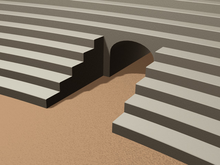Vomitorium

A vomitorium is a passage situated below or behind a tier of seats in an amphitheatre or a stadium, through which big crowds can exit rapidly at the end of an event. They can also be pathways for actors to enter and leave stage.[1] The Latin word vomitorium, plural vomitoria, derives from the verb vomō, vomere, "to spew forth". In ancient Roman architecture, vomitoria were designed to provide rapid egress for large crowds at amphitheatres and stadia, as they do in modern sports stadia and large theatres.[2]
Modern examples

The
The Chichester Festival Theatre, founded in 1962, was the first of its kind to be opened in the United Kingdom for 500 years, because there is no proscenium arch or wings. Instead, there is a thrust stage with vomitoria or "voms" for the audience and performers to enter and exit.[4]
In addition, the Mark Taper Forum, one of the three theatres making up the Los Angeles Music Center, has two vomitoria. It has a strong thrust stage such that the audience sit in an amphitheatre-type array.
Winnipeg's second-largest theatre, Prairie Theatre Exchange, has two vomitoria on either side of its thrust stage, with seating on three sides.
The Space Theatre at the Denver Center for the Performing Arts is a theatre "in the round" with a pentagon configuration. It contains five vomitoria spaced 72 degrees apart, creating five equal seating sections.
Historical notes
A commonly held but erroneous notion is that Ancient Romans designated spaces called vomitoria for the purpose of literal vomiting, as part of a binge-and-purge cycle.[5][6]
References
- ^ "Vomitorium". Oxford Dictionary. Oxford Dictionaries. Archived from the original on February 24, 2011. Retrieved 2 December 2010.
- ^ Longfellow, William P.P., ed. (1903). A cyclopaedia of works of architecture in Italy, Greece, and the Levant. New York: Charles Scribner's Sons. p. xxxii.
- ^ "Timeline | Stratford Festival Official Website".
- ^ "Friday Night Is Music Night". BBC Press Office. 26 January 2016. Retrieved 5 February 2018.
- ^ "World Wide Words: Vomitorium". World Wide Words. Retrieved 27 November 2023.
- ^ Radin, Alice P. (8 January 2003). "Fictitious facts: The case of the vomitorium". APAClassics.org. American Philological Association. Archived from the original on 20 March 2003.
External links
 The dictionary definition of vomitorium at Wiktionary
The dictionary definition of vomitorium at Wiktionary
